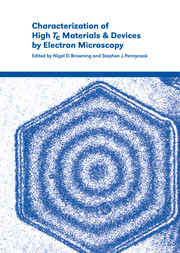Book contents
- Frontmatter
- Contents
- List of contributors
- Preface
- 1 High-resolution transmission electron microscopy
- 2 Holography in the transmission electron microscope
- 3 Microanalysis by scanning transmission electron microscopy
- 4 Specimen preparation for transmission electron microscopy
- 5 Low-temperature scanning electron microscopy
- 6 Scanning tunneling microscopy
- 7 Identification of new superconducting compounds by electron microscopy
- 8 Valence band electron energy loss spectroscopy (EELS) of oxide superconductors
- 9 Investigation of charge distribution in Bi2Sr2CaCu2O8 and YBa2Cu3O7
- 10 Grain boundaries in high Tc materials: transport properties and structure
- 11 The atomic structure and carrier concentration at grain boundaries in YBa2Cu3O7–δ
- 12 Microstructures in superconducting YBa2Cu3O7 thin films
- 13 Investigations on the microstructure of YBa2Cu3O7 thin-film edge Josephson junctions by high-resolution electron microscopy
- 14 Controlling the structure and properties of high Tc thin-film devices
3 - Microanalysis by scanning transmission electron microscopy
Published online by Cambridge University Press: 21 August 2009
- Frontmatter
- Contents
- List of contributors
- Preface
- 1 High-resolution transmission electron microscopy
- 2 Holography in the transmission electron microscope
- 3 Microanalysis by scanning transmission electron microscopy
- 4 Specimen preparation for transmission electron microscopy
- 5 Low-temperature scanning electron microscopy
- 6 Scanning tunneling microscopy
- 7 Identification of new superconducting compounds by electron microscopy
- 8 Valence band electron energy loss spectroscopy (EELS) of oxide superconductors
- 9 Investigation of charge distribution in Bi2Sr2CaCu2O8 and YBa2Cu3O7
- 10 Grain boundaries in high Tc materials: transport properties and structure
- 11 The atomic structure and carrier concentration at grain boundaries in YBa2Cu3O7–δ
- 12 Microstructures in superconducting YBa2Cu3O7 thin films
- 13 Investigations on the microstructure of YBa2Cu3O7 thin-film edge Josephson junctions by high-resolution electron microscopy
- 14 Controlling the structure and properties of high Tc thin-film devices
Summary
Introduction
The electron–specimen interaction not only provides information about the atomic structure of the materials, but also gives clues about other physical properties of the materials. The science of extracting this valuable information from smaller and smaller volumes of specimens is called microanalysis and is a very fruitful development of modern electron microscopy. Playing a pivotal role in this science is the scanning transmission electron microscope (STEM) which was introduced mainly to provide point-by-point analysis at high spatial resolution. The advantage of scanning is that it enables each pixel to be associated with a data set which might be a diffraction pattern, an X-ray emission spectrum, or an electron energy loss spectrum. The advantage of transmission is that it prevents the beam broadening which degrades the resolution of images formed by scanning a bulk sample. In this chapter, we will review the physical principles of the various imaging and analytical techniques available in the STEM, and assess their usefulness in connection with the research into high-temperature superconductors (HTSC). In many ways, there is a large overlap between the requirement of HTSC research and other branches of the material sciences. Thus we hope that our review can also serve as a brief introduction to STEM for researchers both inside and outside the HTSC community. For specific examples of the application of the STEM in HTSC, we will refer readers to other chapters in this book and the original papers.
Electron optics of STEM
There are currently two variants of STEM, depending on whether it is specifically designed for scanning microscopy operation or adopted from conventional transmission electron microscopy work.
- Type
- Chapter
- Information
- Publisher: Cambridge University PressPrint publication year: 2000

